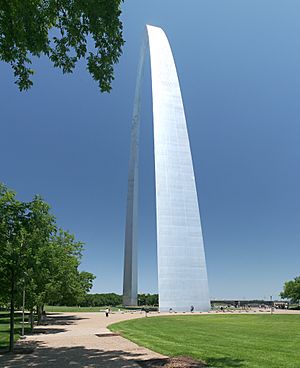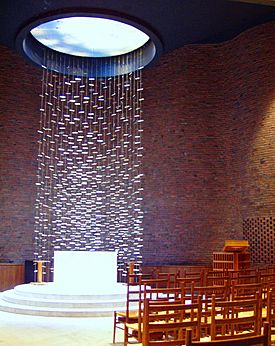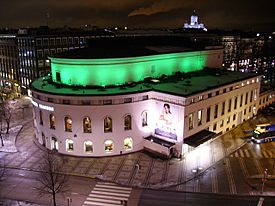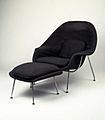Eero Saarinen facts for kids
Quick facts for kids
Eero Saarinen
|
|
|---|---|

Eero Saarinen
|
|
| Born | August 20, 1910 |
| Died | September 1, 1961 (aged 51) |
| Nationality | Finnish American |
| Occupation | Architect |
| Buildings | See list of works |
| Design | Gateway Arch Tulip chair |
Eero Saarinen (born August 20, 1910 – died September 1, 1961) was a famous Finnish American architect and industrial designer. He lived in the 20th century and was known for changing his design style for each project. Sometimes his buildings had simple, curving shapes, and other times they looked very modern and machine-like.
Contents
Biography
Eero Saarinen was born on the same day as his father, Eliel Saarinen. In 1923, when Eero was thirteen, his family moved to the United States of America. He grew up in Bloomfield Hills, Michigan. His father taught at the Cranbrook Academy of Art, where Eero also took classes in sculpture and furniture design. He became good friends with other students like Charles and Ray Eames, and Florence Knoll.
In 1929, he went to Paris, France, to study sculpture. Then, he studied at the Yale School of Architecture until 1934. After that, he traveled around Europe and North Africa for a year. He also spent a year in his home country, Finland.
Eero returned to Cranbrook to work with his father and teach. He became a U.S. citizen in 1940. During World War II, Saarinen joined the Office of Strategic Services (OSS), which was a U.S. intelligence agency. He drew pictures for bomb manuals and designed the Situation Room in the White House. He worked for the OSS until 1944.
After his father passed away in 1950, Saarinen started his own architecture company called "Eero Saarinen and Associates." Sadly, Eero Saarinen died in 1961 from a brain tumor. He was only 51 years old.
Personal life
Eero Saarinen first married a sculptor named Lilian Swann Saarinen. They had two children, Eric and Susan, but they divorced in 1954. Later, he married Aline Bernstein Louchheim, who was an art critic for The New York Times. They had a son named Eames, after his friend and design partner, Charles Eames.
Work
Furniture designs
Eero Saarinen first became known for his furniture designs while working with his father. In 1940, he and Charles Eames won a competition for a chair design.
His famous "Tulip Chair" was made by the Knoll furniture company. This company was started by Hans Knoll, who married Florence Knoll, a friend of the Saarinen family.
Saarinen designed many important furniture pieces for Knoll. These include the "Grasshopper" lounge chair (1946), the "Womb" chair (1948), and the "Womb" settee (1950). His most famous designs are from the "Tulip" or "Pedestal" collection (1956). This collection included chairs, dining tables, coffee tables, and stools. All these designs were very popular, except for the "Grasshopper" chair.
Building designs
One of Saarinen's first well-known buildings was the Crow Island School in Winnetka, Illinois, built in 1940.
While still working with his father, Saarinen won a competition in 1948 to design the Jefferson National Expansion Memorial in St. Louis, Missouri. The famous Gateway Arch was not finished until the 1960s.
Saarinen's first big project with his father was the General Motors Technical Center in Warren, Michigan. This building used a modern style with steel and glass, and blue panels. It was built in 1956. Saarinen used models to help design the center, which allowed him to share his ideas and get feedback.
Because the GM Technical Center was so successful, other large American companies asked Saarinen to design their headquarters. These included John Deere, IBM, and CBS. Even though these buildings looked very modern, their insides often had dramatic staircases and furniture designed by Saarinen.
In the 1950s, he also designed buildings for American universities. These include the Noyes dormitory at Vassar College and the Ingalls Rink (an ice rink) and Ezra Stiles College at Yale University.
Saarinen was also part of the group that chose the design for the Sydney Opera House. He played a key role in selecting the winning design by Jørn Utzon.
His architecture company, "Eero Saarinen and Associates," was located in Bloomfield Hills, Michigan, and later moved to Hamden, Connecticut. Under Eero Saarinen, the firm created many important works. These include the Gateway Arch in St. Louis, Missouri, the Miller House in Columbus, Indiana, and the TWA Flight Center at John F. Kennedy International Airport. He also designed the main terminal of Dulles International Airport near Washington, D.C.. Many of these buildings use special curved shapes in their design.
Saarinen designed the Kresge Auditorium at MIT, which is known for its thin concrete shell. Another building with a thin shell is the Ingalls Rink at Yale University. It has cables connected to a single concrete backbone and is sometimes called "the whale" because of its shape. The TWA Flight Center is seen as one of his best works, showing his artistic style and amazing use of concrete.
Eero worked with his family to design parts of the Cranbrook campus in Bloomfield Hills, Michigan. This included the Cranbrook School, Kingswood School, the Cranbrook Art Academy, and the Cranbrook Science Institute. Eero's beautiful stained-glass designs are a key part of these buildings.
After Saarinen's death, his partners, Kevin Roche and John Dinkeloo, finished his ten remaining projects, including the St. Louis Arch. The company's name was then changed to "Kevin Roche, John Dinkeloo, and Associates," or Roche-Dinkeloo.
Reputation
Eero Saarinen was chosen as a Fellow of the American Institute of Architects in 1952. He also won the AIA Gold Medal, which is a very high honor in architecture.
Today, Eero Saarinen is considered one of the most important American architects of the 20th century. People have become more interested in his work recently. There have been big exhibitions and new books about him. This is partly because his old office donated his design papers to Yale University. Also, his work, which used many different styles, seems to fit well with today's ideas about design.
Some people criticized him during his lifetime for not having one clear style. But one reason for this was that Saarinen changed his modern design ideas to fit each client and project, as no two projects were ever exactly alike.
Works
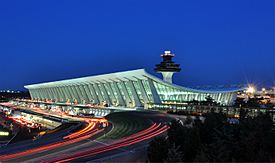
- Remodeling of the Swedish Theatre, Helsinki (with Jarl Eklund)
- Concordia Senior College campus, now Concordia Theological Seminary, Fort Wayne, Indiana
- The Law School at the University of Chicago, Chicago, Illinois.
- The Miller House, Columbus, Indiana.
- Berkshire Music Center, Opera Shed Tanglewood, Massachusetts.
- Gateway Arch, St. Louis, Missouri
- TWA Terminal at JFK International Airport
- Washington Dulles International Airport
- Kresge Auditorium and MIT Chapel at MIT
- Bell Labs Holmdel Complex in Holmdel, New Jersey
- Case Study House #9, the John Entenza House (collaboration with Charles Eames)
- CBS Building (Black Rock) New York
- Vivian Beaumont Theater in Lincoln Center, New York
- General Motors Technical Center, Warren, Michigan
- US Embassies in Oslo and London
- North Christian Church in Columbus, Indiana
- Law School and Woodward Court dormitory (demolished 2002) at the University of Chicago
- Kleinhans Music Hall, Buffalo, New York; designed in collaboration with his father Eliel Saarinen
- Ezra Stiles College, Morse College, and Ingalls Rink (affectionately known as "The Whale") at Yale University
- Noyes House dormitory at Vassar College. Its lounge is affectionately called the Jetsons lounge because of its curved architecture.
- Hill College House at the University of Pennsylvania. Originally a women's dormitory, the building was made with a "drawbridge" to symbolically keep men out.
- IBM Pavilion, 1964-1965 New York World's Fair
- IBM's Thomas J. Watson Research Center in Yorktown Heights, New York
- IBM Rochester, a plant in Rochester, Minnesota
- John Deere World Headquarters, Moline, Illinois
- The "Tulip chair", popularized by its use on the original Star Trek television series (1966–69).
- The "Womb" chair
- North Campus, University of Michigan, Ann Arbor, Michigan
- Earl V. Moore Building, housing the University of Michigan School of Music
- East Terminal at Ellinikon International Airport, Athens Greece, posthum finished.
- Milwaukee County War Memorial Center, Milwaukee, Wisconsin
- Medbury, Fitch and Harvey Ingham Halls, Quadrangle Dormitories ("The Quads"), Hubbell Dining Hall, and Oreon E. Scott Chapel at Drake University in Des Moines, IA
- Firestone Baars Chapel at Stephens College in Columbia, Missouri.
- Crow Island School
- Selected projects
-
1953 Kresge Auditorium, MIT campus, Cambridge, Massachusetts
-
North Christian Church, Columbus, Indiana
-
1953 Emma Hartman Noyes house, Vassar College campus, Poughkeepsie, New York
Related pages
- Eero Saarinen structures
- Thin-shell structure
- Tensile architecture
- List of notable brain tumor patients
An exhibition about Saarinen's work, called Eero Saarinen: Realizing American Utopia, has traveled in Europe and the USA. It was put together by the Finnish Cultural Institute in New York, with the Yale School of Architecture and the Museum of Finnish Architecture.
In 1973, the Aline and Eero Saarinen papers were given to the Archives of American Art, Smithsonian Institution. These important documents about Eero and Aline Saarinen were later put online in 2006.
- National Building Museum
Images for kids
-
Washington Dulles International Airport in Washington, D.C.
-
Fluid and open interior space, typical of Saarinen's style, is evident in the TWA Flight Center
-
Tulip chair and seat cushion, designed 1956, Brooklyn Museum
See also
 In Spanish: Eero Saarinen para niños
In Spanish: Eero Saarinen para niños



